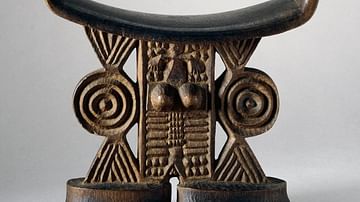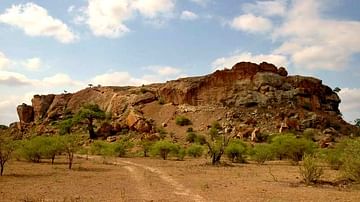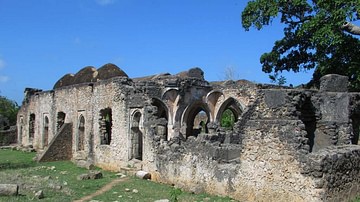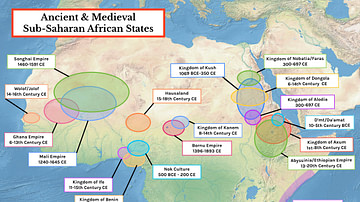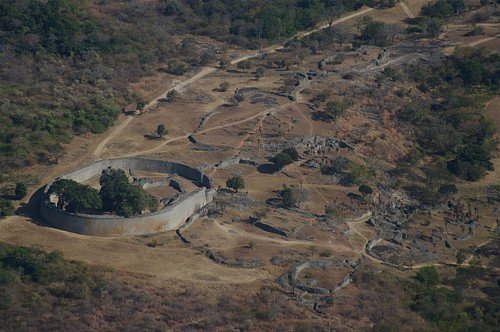
Great Zimbabwe is a ruined city near Masvingo, central Zimbabwe which was inhabited between c. 1100 to c. 1550 (flourishing c. 1300 - c. 1450) in the region’s Late Iron Age. Capital of the Kingdom of Zimbabwe of the Bantu-speaking Shona people, it is located on a natural citadel and includes many impressive monuments built using granite blocks without mortar.
Clusters of stone buildings were called zimbabwe in Bantu, hence the site and the kingdom's name. One stone structure, the Great Enclosure - a high circuit wall and tower - is the largest ancient monument in Africa south of the Sahara. The city prospered thanks to agriculture, gold deposits, and a trade network which reached the East African coast. It went into decline in the 15th century, probably due to its sources of gold being exhausted or overpopulation, and the Shona moved northwards to a new site at Mutapa. Several soapstone figurines discovered at Great Zimbabwe represent a bird, and this creature today appears on the flag of modern Zimbabwe. Great Zimbabwe was designated a UNESCO World Heritage Site in 1986.
The Zimbabwe Plateau
The Kingdom of Zimbabwe, of which Great Zimbabwe was its capital, was formed by the Shona, a Bantu-speaking people that had first migrated to southern Africa from the 2nd century CE. The exact confines of the kingdom are not known except that its heartland was in central Mashonaland (northern Zimbabwe). The region of the Zimbabwe plateau, located between the Limpopo River in the south and the Zambezi River in the north, is composed of temperate grasslands which are free of the tsetse fly, although rainfall has always been unpredictable with the threat of drought at least once a decade.
The general history of the region in the millennium before Great Zimbabwe was at its height is as follows. From the 3rd century BCE, there is evidence of sheep, goat, and cattle domestication although the practice was not widespread until the 1st century CE. Certainly, small bands of nomadic hunter-gathers had inhabited the area long before the Shona pastoralists arrived with their livestock and iron-smelting technology and, indeed, the two groups would continue to compete for territory right into the modern era.
By the 7th-9th century, communities were established along a pattern which would survive until European colonists arrived from the 16th century. People lived in mud and reed thatch or stone houses. Simple pottery was made, leather for clothing was produced from hides, jewellery was made from copper and gold, and weapons and farming implements from iron. These items were also traded in the region, salt being a valued and needed commodity in the Zimbabwe kingdom. There are also finds of glass beads and seashells, evidence of trade with the coast even at this early date.
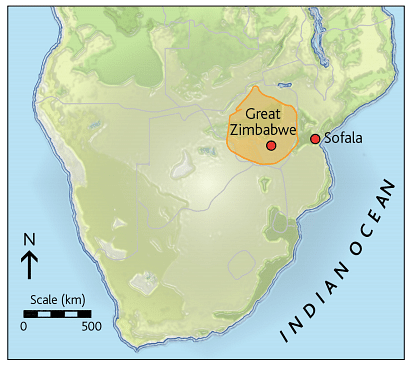
The cumulative archaeological evidence points, then, to a society which, from the 10th century, prospered from farming (especially of sorghum, millet, pumpkins, and watermelons), animal husbandry, hunting, and localised trade (using local iron, copper, and gold deposits). As these communities prospered, and as their trade network expanded to the great trade centres of the Swahili coast, so they were able to build more impressive stone monuments from the beginning of the 2nd millennium. Great Zimbabwe, located some 30 km (19 miles) southeast of modern Masvingo, is only the largest of over 300 Iron Age stone sites in the region which today covers modern Zimbabwe and Mozambique.
Architectural Features
Hill Complex
The location of Great Zimbabwe on a natural rise 80 metres (262 ft) high provided both a prominent site for rituals and a place easy to defend. Evidence of a sparse habitation on the citadel, or Hill Complex as it is sometimes known, dates back to the 5th century (according to radiocarbon dates) but was then interrupted and resumed in greater intensity in the 11th-12th century when Iron Age peoples arrived there whose material culture was different from that of the previous occupants. The complex may have functioned at this later date as a religious site, perhaps as a place of burial for chiefs. Alternatively, it may always have functioned as a religious site where ancestors were worshipped and given sacrifices and votive offerings. However, there are remains of mud housing with stone foundations on the acropolis, and it is possible it was used as a royal residence. Sometime in the mid-13th century, the Hill Complex was surrounded by a dry stone wall of granite, a stone which occurs locally and can be easily and naturally split (using fire and then cooling water) into relatively uniform slabs measuring 50-100 cm (19-39 inches) in thickness. This wall incorporates naturally occurring granite boulders.
Great Enclosure
From c. 1000 (if not earlier), the valley below the citadel was inhabited, too. Dominating it is a 13-14th century large elliptical stone wall 5.5 metres (18 ft) thick in places and 9.7 metres (32 ft) high. The wall inclines slightly inwards for added stability and regular channels run through the base to drain the level interior space. There is also a main entrance doorway which faces the Hill Complex and several others which would seem to rule out any military or defensive function of the walls.
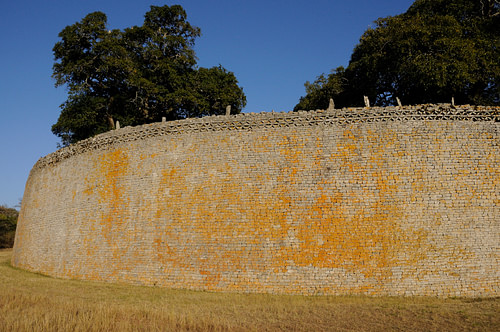
Inside is a second wall which in places forms a narrow corridor as it follows the contours of the outer wall and which leads to a tall stone monument or tower. The tower is conical in shape, 5 metres (16 ft) across at its widest part, and reaches a height of 10 metres. Built using drystone granite masonry with precise coursing, the wall and tower are commonly referred to as the Great Enclosure.
The purpose of the structure, which has a total circumference of 250 metres (820 ft), is not known for certain but it may have been a royal residence with the tower used as a granary (grain being a common form of tribute and used by Shona rulers to present as a gift). The most luxurious artefacts of Great Zimbabwe have been found here and at the Hill Complex. However, the peculiar arrangement of the walls and interior platforms and stone buttresses are difficult to explain as a mere residence. Whatever the exact function, most scholars are in agreement that the Great Enclosure would have served as a potent symbol of the prestige and authority of the rulers of Great Zimbabwe.
Valley Ruins
There are, too, many other individual stone buildings also surrounded by high walls in the vicinity, as well as the remains of many large circular mud and pole houses (which pre-date the stone ones). This third area is known as the Valley Ruins. The mud houses are often 10 metres (32.8 ft) in diameter and so the height with their thatch roofs would have been an imposing 6 metres (19.7 ft) or more.
The number and geographical spread of these ruins would suggest an increase in population as the city prospered. Spread over an area of 1700 acres (700 hectares) and with such monumental structures, there was surely a ruling elite and perhaps a centralised authority which ruled over a total population of around 18,000 people. Contact with contemporary cultures in the region is suggested by the similarity of such items as iron bells, traditionally associated with rulers, found at the site and in Shaba and Ingombe Ilede on the middle Zambezi river.
Government & Society
Zimbabwe society, as in other parts of southern Africa, was dominated by male family heads who competed with their peers for power and influence. One of the main methods of acquiring such power was the ownership of cattle. The number of a man's wives was another indicator of success because this corresponded to the labour at his disposal. Women were expected to sow, tend crops, and harvest them, prepare food, and fetch water. Unmarried males hunted, herded animals, and made clothing. Men who had no property of their own might become a dependent of a man with property, who allowed them to assist in herding duties in return for food and shelter. Such dependents were another indicator of a male's success in Zimbabwe society.
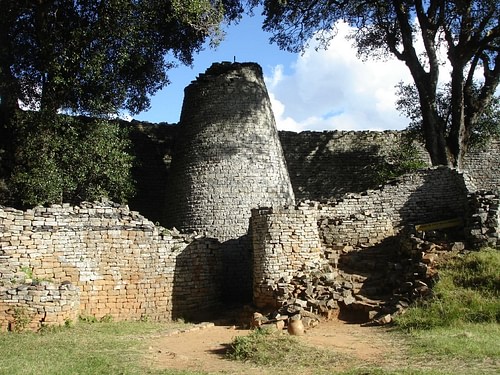
The chief of a tribe was likely the wealthiest male, although the post was usually hereditary amongst the Shona. A chief had no army to support his authority and so it is probable that most chiefs sought to accommodate the views of their community's senior males and subordinate chiefs under their nominal control. Archaeological evidence of fire destruction at some sites suggests there were occasional conflicts between competing groups. The stone monuments, at least, are evidence of some sort of political authority, but just what that consisted of is unknown other than that it was rich enough and controlled sufficient labour to build such massive structures.
The male children of the tribe's herd-owning males were educated with their peers for a number of months in isolation from the community. The boys were taught hunting skills, had to endure physical hardship and endurance tests, and were taught the traditions and customs of the tribe. At the end of the training period, they were circumcised and given a new name, which meant the boys had become men. Girls were also given group education where they were prepared for their future role as wives and mothers. When a girl did marry she left her home and lived with the family of her husband, her father presenting a dowry of cattle.
Trade
That Great Zimbabwe had trade links with other states further afield is evidenced by finds of even non-African goods which came via merchants of the East African coast 400 km (250 miles) away. Kilwa and its outpost of Sofala - located in modern Mozambique - became the most prosperous of all the Swahili trading posts thanks to the gold that came in from the kingdom of Zimbabwe. This gold was easily acquired from surface deposits across the Zimbabwean plateau and in the tributaries of the Zambezi River. When these sources were exhausted open mines were dug to a depth of 30 metres (100 ft). Gold, ivory, and copper (often cast in x-shaped ingots) was exchanged for such exotic luxury goods as Chinese Ming porcelain and carved faience from Persia. There were no markets, and this trade was done by barter for the benefit of the ruling elite. There is, then, ample evidence of the wealth this interregional trade brought to the city not only in finds of foreign luxury artefacts but also in both its architecture and art.
Art
Unfortunately for posterity, the site of Great Zimbabwe was systematically looted of anything of value during the European colonialists' activities in the area in the 1890s. Those artefacts that have found their way into the public arena are almost always without any information as to the context in which they were found.
A number of finely carved soapstone figures have been found which include eight representations of birds perched on monoliths over one metre (39 inches) in height. The bird is known as the Zimbabwe Bird and does not resemble any bird in nature; it appears on the flag of the country today. Such artefacts as the soapstone figures hint at the ritual nature of the Great Zimbabwe site. Other sculptures include cattle and nude highly-stylised female figures. Simple unglazed pottery of very good quality was produced - very often given a graphite covering and then polished. Forms include gourd-shaped vessels with distinctive hatched triangular decorations, small disks of uncertain purpose, and models of huts.
Decline & Later History
The precise causes of Great Zimbabwe's decline are not known but competition from rival states and the working out of gold deposits are the most likely explanations. There may have been problems caused by overpopulation, too, such as overworking of the land and deforestation, a situation perhaps brought to crisis point by a series of droughts. Certainly, by the 15th century, any links with coastal trade have ceased. By the second half of that century, the Shona peoples had migrated a few hundred kilometres northwards and formed a new state, the Kingdom of Mutapa. The city of Great Zimbabwe was, thus, largely abandoned, not to be 'rediscovered' until the Europeans arrived in the late 19th century. Blinded by their racism, they could not bring themselves to believe that such a place could have been built by black Africans. This prejudice continued right through to the late 20th century and led to all manner of outlandish explanations for the large stone structures such as wandering Phoenicians setting up a city thousands of miles from their homeland and as far from the sea as physically possible. Archaeological evidence, however, has proved that Great Zimbabwe was built by indigenous black Africans.
The territory once held by the Kingdom of Zimbabwe was still populated but conquered by the Ndebele people in the 19th century when the Kingdom of Matabeleland was formed. By the early 20th century the region was under control of the British South Africa Company, and two new states were formed in 1911: Northern and Southern Rhodesia. The latter state would become the modern country of Zimbabwe in 1980.
